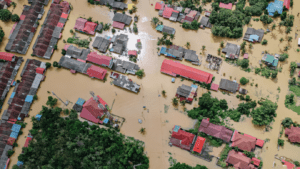
Introduction
Climate change presents a profound challenge for Malaysia, with its unique biodiversity and rapidly developing economy. Recent academic studies indicate shifts in weather patterns, rising temperatures, and changing rainfall regimes, affecting everything from agriculture to urban infrastructure. What is the current academic understanding of climate changes that impact Malaysia? What are the strategies to combat these changes? Information on the impact of climate changes in Malaysia is somewhat scarce from government sources. Consequently, this article primarily refers data and findings from international entities. The insights discussed herein are drawn from the World Bank and the Asian Development Bank’s “Climate Risk Country Profile – Malaysia,” published in 2021, as well as the United Nations’ “2020 Status Report on Disaster Risk Reduction in Malaysia,” also released in 2021.

Dr Darween Rozehan Shah Iskandar Shah is a lecturer at AHIBS with a specialization in Healthcare Industry Development and Healthcare Management. He granted his Master in Public Health from University of Malaya, while Medical Degree and Bachelor of Medical Sciences from Indonesia. Currently he is a PhD Candidate in Environmental Health Engineering at University of Malaya. His area of expertise includes Public and Global Health, Healthcare Policy and Improvement, Environmental Health and Engineering, Sustainable Environment, Sustainable Waste Management, Sustainable Inno-Prenuers, and Circular Economy.
Observable Impact of Climate Changes in Malaysia
Malaysia’s climate has shown increased variability with more frequent and intense weather events. The alteration in rainfall patterns has led to droughts in some areas and floods in others, disrupting local ecosystems and human settlements alike. This section would detail the specific changes observed, drawing from studies conducted by Malaysian meteorological departments and universities. The World Bank reports that from 1970 to 2013, the regions of Peninsular Malaysia, Sabah, and Sarawak witnessed a rise in surface mean temperatures ranging from 0.14°C to 0.25°C per decade. Additionally, during the same period, surface maximum temperatures saw an increase ranging from 0.17°C to 0.22°C per decade, while surface minimum temperatures showed a rise between 0.20°C to 0.32°C per decade. This data suggests that the frequency and severity of heatwaves are projected to significantly escalate as a consequence of the warming climate.
 The World Bank cited a study conducted by Mayowa et al. in 2015, which examined rainfall patterns on the east coast of Peninsular Malaysia from 1970 to 2010. The study identified a notable uptick in annual rainfall during the monsoon season, along with a rise in the count of days characterized by heavy rainfall, defined as days with precipitation exceeding 20mm. Malaysia faces heightened susceptibility to flooding, marked by a rise in both the occurrence and severity of flood events over the past few decades. In the Klang Valley region, inhabitants may vividly remember the severe flooding episodes of the last two years, in stark contrast to earlier times when such inundations were infrequent.
The World Bank cited a study conducted by Mayowa et al. in 2015, which examined rainfall patterns on the east coast of Peninsular Malaysia from 1970 to 2010. The study identified a notable uptick in annual rainfall during the monsoon season, along with a rise in the count of days characterized by heavy rainfall, defined as days with precipitation exceeding 20mm. Malaysia faces heightened susceptibility to flooding, marked by a rise in both the occurrence and severity of flood events over the past few decades. In the Klang Valley region, inhabitants may vividly remember the severe flooding episodes of the last two years, in stark contrast to earlier times when such inundations were infrequent.
According to the findings from the World Bank, research indicates that due to the climate changes, the projected median increased in the population impacted by an extreme river flood, falling within the 90th percentile, is approximately 102,290 individuals by the period between 2035 and 2044. This represents a substantial surge of 140 percent compared to the population exposed to such events from 1971 to 2004. The World Bank predicts that the climate changes will lead to an escalation in the intensity of tropical storms in Southeast Asia.
 Observing the vast deforested areas during a flight from Sabah or Sarawak to Peninsular Malaysia can evoke a sense of sadness. According to Global Forest Watch, Malaysia has experienced significant deforestation between 2002 and 2021, losing 2.77 million hectares of primary humid forests, which constitutes 33 percent of the total tree cover loss during the same period. Malaysia’s humid primary forest area has diminished by 17 percent during this timeframe. Furthermore, from 2001 to 2021, Malaysia witnessed a loss of 8.67 million hectares of tree cover, equivalent to a 29 percent reduction in tree cover since the year 2000. Among the affected regions, Sarawak, Sabah, and Pahang had the highest tree cover losses, amounting to 3.11 million hectares, 1.74 million hectares, and 1.19 million hectares, respectively, surpassing the national total of 542,000 hectares.
Observing the vast deforested areas during a flight from Sabah or Sarawak to Peninsular Malaysia can evoke a sense of sadness. According to Global Forest Watch, Malaysia has experienced significant deforestation between 2002 and 2021, losing 2.77 million hectares of primary humid forests, which constitutes 33 percent of the total tree cover loss during the same period. Malaysia’s humid primary forest area has diminished by 17 percent during this timeframe. Furthermore, from 2001 to 2021, Malaysia witnessed a loss of 8.67 million hectares of tree cover, equivalent to a 29 percent reduction in tree cover since the year 2000. Among the affected regions, Sarawak, Sabah, and Pahang had the highest tree cover losses, amounting to 3.11 million hectares, 1.74 million hectares, and 1.19 million hectares, respectively, surpassing the national total of 542,000 hectares.

The economic and social implications of climate changes in Malaysia are profound. Agriculture, a significant sector of Malaysia’s economy, faces unpredictable harvests due to climate variability. Climate changes exert both direct and indirect influences on food production, negatively affecting various aspects of crop growth processes. Direct effect encompassed changes in factors like carbon dioxide levels, precipitation patterns, and temperatures. Indirect consequences involve impacts on water availability and timing, soil organic matter and erosion, shifts in pest and disease profiles, the emergence of new invasive species, and a decrease in arable land due to coastal submergence. According to the World Bank, the occurrence of droughts and floods early in the rice growing season has the potential to reduce yields by as much as 60 percent. Additionally, drought conditions may lead to an inability to cultivate rubber, palm oil, and cocoa crops.
Socially, communities particularly those in coastal and low-lying areas are grappling with the loss of homes and livelihoods due to extreme weather events. The climate changes will cause the impact and potential long-term effects to Malaysian population. A connection exists between heat stress and its impact on labour productivity, household spending habits, and overall living standards. This issue is further exacerbated by Urban Heat Island (UHI) conditions, characterized by factors such as dark surfaces, heat generated from residential and industrial sources, a lack of greenery, and air pollution. UHI conditions can elevate temperatures significantly, often ranging from 0.1 to 3°C higher than in rural areas, particularly in densely populated global mega-cities. Kuala Lumpur has experienced UHI temperatures within the range of 4 to 6°C, with these elevated temperatures often reaching their peak during the night-time hours. These heightened temperatures have a direct impact on human health and labour productivity. UHI conditions also contribute to instances of haze pollution, which can have significant economic consequences. For example, it was estimated that the economic damage caused by haze in Kuala Lumpur in 1997 amounted to approximately US$321 million. Moreover, research indicates that a mere one-degree increase in the ambient temperature can lead to an average rise in electricity demand ranging from 0.5 to 8.5 percent, with subsequent implications for climate changes.
Government and Policy Responses to Climate Changes
In response to these challenges, Malaysian government has initiated several policies aimed at mitigation and adaptation of climate changes. The National Policy on Climate Change and the Malaysia Plan outline strategies for reducing greenhouse gas emissions and enhancing resilience to climate impacts. How effective are these policies and the academic discourse surrounding them? The effect of climate changes in Malaysia are a pressing concern that requires immediate and sustained action. While the government has begun to address these issues, there is a critical need for continued research and innovative solutions. To enable the public to contribute effectively to climate change adaptations, it is essential that we are well-informed about the impact of climate changes in Malaysia.
